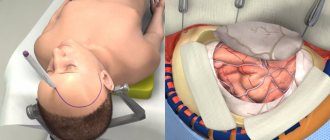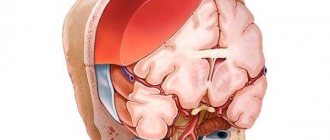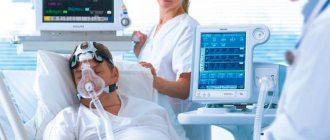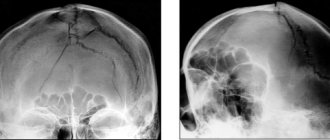Content:
- Features of coma in drug addicts
- Why does a drug-induced coma develop?
- Signs of a drug-induced coma 3.1. How coma begins in drug addicts 3.2. Progression of drug-induced coma
- How is drug-induced coma treated?
The consequences of a drug-induced coma are terrible. Very often this condition leads to disability, mental disorders and death. You shouldn't even try to treat it yourself. By delaying contacting a narcologist, the addict risks death.
Restoration of motor activity
On the first day, you need to lie on your back so that it is easier for the kidneys to work and the stitches do not come apart. They are allowed to move their limbs carefully and do breathing exercises. After laparoscopic partial nephrectomy, you can get out of bed and walk the next day. Open surgery requires more careful movements: on day 2 you can turn to one side, sit down and stand up on day 3.
When the stitches are removed in 7-10 days, you need to expand your activity: move as much as possible, do gymnastics and yoga. This eliminates congestion in the abdominal cavity and lungs, helps cleanse the kidneys and normalize intestinal function. The main limiter here is general weakness. It will take some time to overcome it.
In the photo: asanas that improve kidney function
Features of coma in drug addicts
Coma in drug addicts provokes respiratory depression and blocks the normal functioning of the central nervous system. It develops after consuming narcotic salt, barbiturates, spice, and opiates. All of these substances have an incredibly powerful effect on the human body, so it is quite easy to overdose on them.
From the outside it may seem that the drug addict is sleeping. In fact, he is in a coma. He does not respond to external stimuli and does not control his own physiological urges. Unable to interact with others.
Mechanism of action of coma
This human condition is based on two main mechanisms:
- bilateral damage to the cerebral cortex;
- primary or secondary damage to its trunk, where the reticular formation is located, which maintains the cerebral cortex in tone and activity.
This is a cerebral coma.
Damage to the brain stem occurs when a person has a stroke or traumatic brain injury. Secondary disorders, as a rule, occur when metabolic processes in the body change, for example, in case of poisoning, diseases of the endocrine system, etc.
In addition, there are cases of a combination of both mechanisms of coma, which is observed quite often. It is believed that this is the line between life and death.
As a result of this, the normal transmission of nerve impulses in the human brain becomes impossible, the activity of all structures that switch to an autonomous mode is lost. Thus, the brain temporarily ceases to function and control the processes occurring in the body.
Why does a drug-induced coma develop?
The worst consequence of a drug-induced coma is death. To prevent such an outcome, it is necessary to understand why a coma develops.
The fact is that synthetic drugs contain a large number of various toxic additives. Trying to save money, drug addicts buy surfactants made in artisanal conditions. After taking them, they experience a sharp deterioration in well-being, which leads to coma.
Also, this complication of drug addiction occurs when using high doses of surfactants.
Drugs disrupt the metabolic processes occurring in the brain and do not allow nerve impulses to pass through the fibers. More often than others, people who use barbiturate-type sleeping pills, spice, designer salt, morphine, methadone, and heroin face the consequences of a drug-induced coma.
Narcologists know of many cases when patients who fell into a coma did not have time to be taken to the hospital - they died at home or on the way to the hospital. Even if doctors manage to save the life of an addict, one can never rule out the occurrence of serious disorders that will make him incapacitated.
A young mother fell into a coma after surgery for appendicitis
A resident of the republic contacted the editors of “Pro City” with a problem. The man said that in early December his young wife was taken by ambulance from her home. After a simple operation, the woman fell into a coma. Today she is in the Republican Hospital, as her husband said.
On December 7, an ambulance took a 21-year-old woman to the Batyrevsky district hospital. The last time she called her husband was on December 8th at approximately 0:30. In the conversation, the woman mentioned that doctors could not understand the cause of her condition and were inclined to believe that it was appendicitis. The husband reports that after the operation his wife became ill and fell into a coma, in which she remains to this day.
“After the operation, she developed breathing problems and started having seizures. She didn’t regain consciousness,” says her husband.
After this, as the husband says, the woman was connected to a ventilator and administered sedatives. Batyrev’s doctors tried to understand what was wrong, but they failed, and the convulsions continued. On December 10, Batyrev’s doctors called their Cheboksary colleagues. Neurologists and resuscitators from the Republican Hospital arrived at the hospital. However, in the evening the woman became worse and fell into a coma, her husband says.
After this, doctors decided to transport the woman to Cheboksary. On December 12, she was already in the intensive care unit of the Republican Hospital. According to the man, his wife has been unconscious since December 10 to this day.
Only on December 18 did he manage to learn about the diagnosis of multiple organ failure. The man was told about this during a consultation to which he was invited by the hospital administration. However, what led to the coma is not yet known, as the patient’s husband said.
“They say they are trying to do everything possible. I don’t know why this happened, could it be because of the removal of appendicitis? I always went to the doctor. I gave birth three months ago, had examinations, everything was fine,” said the woman’s husband.
The administration of the Republican Hospital also commented on the current situation. Deputy Chief Physician Tatyana Vinokur said that all necessary therapeutic and diagnostic measures are being taken for the patient, adjusted with specialists from leading federal clinics, so that the woman’s condition improves. According to the doctor, an emergency vehicle with the latest equipment was used to deliver her from the Batyrevskaya hospital. Experts assure that they are directing all possible resources to improve the patient’s condition and hope for the best.
“We are doing everything to improve her condition. We consulted with the main specialists of the Volga region and held a video conference with doctors from the Moscow region,” says Tatyana Vinokur.
The Ministry of Health of Chuvashia also commented on the situation, saying that the doctors of the Republican Hospital are doing everything possible for the patient’s recovery.
Signs of a drug-induced coma
What signs of a drug-induced coma will appear in a drug addict are determined by the type of drug used and its doses. The sooner treatment is started, the better. At the initial stage of intoxication, the probability of survival is very high. If relatives call the doctor late, death is possible.
How does coma begin in drug addicts?
The patient takes another dose of the drug and falls asleep. In his sleep, he begins to develop a comatose state. It is characterized by the following symptoms:
- loss of consciousness;
- decreased sensitivity;
- lack of basic neurological reflexes;
- weak response to pain;
- muscle relaxation;
- convulsions.
The pupils stop responding to light. Sometimes a pathological Babinski reflex is recorded - when the foot is irritated, the big toe reflexively bends. Breathing remains rhythmic, pulse rate and body temperature are within the physiological norm.
Progression of drug-induced coma
If medical care is not provided to the patient in the first stage of coma, his condition will continue to worsen. The muscles will relax completely, the badges will expand, the tongue will begin to fall into the throat (this can cause suffocation). Breathing processes will be disrupted. Depression of the respiratory center in the brain may occur. Then the addict will die from asphyxia.
Due to oxygen deficiency, the skin acquires a bluish tint. At some point, a blockage of the vasomotor center may occur. Then the blood vessels and heart will be at risk. The blood flow will be disrupted, tachycardia and arrhythmia will develop. Blood pressure will drop sharply. Urine will stop coming out. Possible pulmonary edema.
In drug-induced coma, death is usually a consequence of cardiac arrest or asphyxia. Sometimes doctors manage to save patients who were on the verge of death. But even with successful therapy, severe consequences for physical and mental health persist.
Types of complications after tooth extraction
Problems that may arise after operations are usually divided into two groups. The first group includes general complications:
- a sharp drop in blood pressure (collapse);
- reflex changes in blood vessels due to insufficient level of pain relief;
- change in consciousness (fainting) due to fear;
- shock, including pain due to inappropriate anesthesia.
The incidence of general complications is low. Usually they are limited to short-term fainting, from which the patient is brought out with the help of ammonia. If the anesthesia is insufficient, the patient experiences pain, which he reports to the doctor - the issue of increasing the concentration of the substance used or choosing a different method of pain relief is decided.
A local complication after tooth extraction is considered to be a pathological condition localized at the intervention site. It does not affect the body as a whole, but causes serious inconvenience to the patient.
Local complications after tooth extraction include:
- bleeding at the site of the extracted tooth;
- paresthesia;
- fracture and dislocation of the jaw;
- leaving particles of the extracted tooth in the gums;
- alveolitis;
- perforation of the maxillary sinus;
- removal of a baby tooth along with the germ of a permanent one;
- root wedging into soft tissue;
- osteomyelitis and other complications of a purulent nature;
- bite pathology;
- traumatic removal of the maxillary tubercle;
- injury to nearby teeth (luxation or fracture);
- root or crown fracture;
- injuries to the gums, tongue and soft tissues;
- aspiration of a tooth or its root.
Each type of complication has its own treatment method. It is important for patients to seek medical help as soon as symptoms appear to help avoid the development of serious pathologies.
How is drug-induced coma treated?
The most important thing when a drug addict develops a coma is to remove the drug from the body as soon as possible. To do this, the following procedures are carried out:
- Infusion therapy. The patient is given a cleansing drip and absorbents are administered. Drugs in this group bind and neutralize toxic compounds.
- Tracheal intubation, gastric lavage by introducing a magnesium solution into it. These measures help avoid choking and reduce the absorption of drugs in the stomach.
- Infusion supplemented with a strong diuretic. The doctor increases the water load by administering intravenous glucose, potassium chloride and sodium bicarbonate. At the same time, he gives the patient a diuretic. As a result, acid-base balance and blood pressure are normalized, and kidney function is stabilized.
- Hemodialysis. Effective in the first few hours of coma. Can only be used when the heart is functioning normally. The technique is an extrarenal blood purification. It allows you to quickly remove toxins and normalize water and electrolyte balance.
Since coma remains at high risk of asphyxia, doctors pay special attention to supporting the lungs. If symptoms of suffocation occur, the patient is connected to a ventilator and given oxygen therapy. If necessary, perform emergency intubation. If edema of the pulmonary tissues has developed, antifoam agents and cardiac glycosides are prescribed. In case of severe intoxication, antidotes are included in the therapeutic regimen.
Any drug addict can experience a coma. This is because a person gets used to one dose of a surfactant and begins to gradually increase it. So, unnoticed by himself, he creates the conditions for an overdose and coma.
Don't let psychostimulants ruin your life. Treat drug addiction and recover.
Indications for use
Putting a person into a state of sedation is necessary when there is damage to the brain, especially to its cortex. This method is used to prevent life-threatening hemorrhages. Thanks to the procedure, intracranial pressure is significantly reduced and swelling of the meninges is reduced. As a result, doctors manage not only to eliminate the emerging pathologies, but also to stop the process of tissue death.
Indications for induction into a medically induced coma also include operations on the heart and brain. It is possible to use the technique in newborns with asphyxia and prolonged oxygen starvation in the womb. Recently, sedation has been used in the treatment of rabies. Patients are put into artificial sleep to avoid the development of irreversible changes in the brain. An artificial coma after surgery may also become a necessary measure if complications arise during the surgical intervention.
Modern principles of intensive care
Therapy in the post-resuscitation period is carried out according to the following principles: extracranial and intracranial measures.
Extracranial events:
1. Since the level of cerebral blood flow becomes dependent on the level of mean arterial pressure, it is recommended to provide hypertension (MAP) in the first 15–30 minutes after successful resuscitation
2. Maintaining normal levels of PaO2 and PaCO2.
3. Maintaining normothermia of the body. The risk of poor neurological outcome increases for every degree >37°C.
4. Maintaining normoglycemia (4.4–6.1 mmol/l). Hyperglycemia is associated with poor neurological outcome.
5. Maintaining hematocrit level within 30–35%. Carrying out mild hemodilution, which ensures a decrease in blood viscosity, which significantly increases in the microvasculature due to ischemia.
6. Control of seizure activity by administering benzodiazepines.
The modern concept of cerebral resuscitation is presented in the figure









